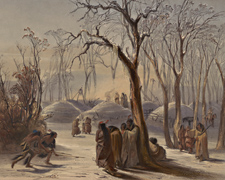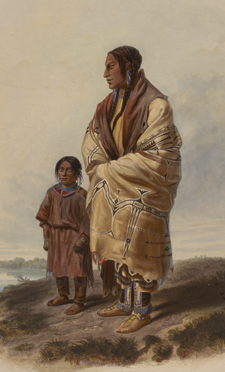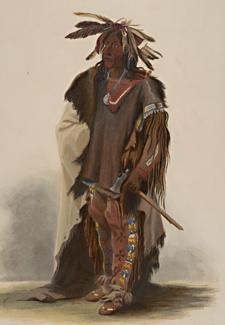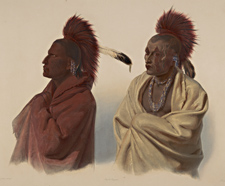
Vanished Worlds, Enduring People
Illustrated Works
Prince Maximilian & Karl Bodmer, 1833-1834
The American Fur Company’s boat, the Yellowstone, steamed up the Missouri River in April 1833 toward Fort Union in what is now North Dakota, carrying provisions for the company’s posts and trade goods for barter with the Indians. The most remarkable of her more than 100 passengers was the German prince, Alexander Philipp Maximilian, Prince of Wied (1782-1867), a naturalist and ethnologist intent on studying the native tribes of America’s west. With him was Karl Bodmer (1809-1893), a young, professionally trained Swiss artist, hired to illustrate the book that would result from this journey.
The diverse Plains Indian tribes the two men encountered, during their thirteen-month sojourn up the Missouri and back to St. Louis, included the Mandan, Minitaree (Hidatsa), Cree, Assiniboine, Blackfeet (Amskapi Pikuni), and Gros Ventres (A’ani). They stopped for long periods of time at the Company’s posts, while Prince Maximilian interviewed Indians visiting the area to trade, or living nearby. He kept a detailed journal of these conversations, observations of ceremonies he witnessed, and descriptions of Indians’ homes and lifestyles. Karl Bodmer had time to paint his subjects and scenes carefully, incorporating exact details into the watercolors and drawings he executed, often taking two or three days to complete a study. Their precise accounts and detailed paintings illuminate life on the Plains only a few years before it changed forever.
Maximilian’s two-volume account and Bodmer’s accompanying atlas of hand colored, aquatint engravings were hailed as ethnographic masterpieces when they appeared in 1839. They remain so today.
Maximilian, Prinz von Wied. Reise in das innere Nord-America in den Jahren 1832 bis 1834. Atlas. “Winter Village of the Minatarres,” illustrated by Karl Bodmer. Coblenz: J. Hoelscher, 1839-41. [view]
Maximilian’s account of his North American sojourn was first published in Germany, and issued to subscribers in parts over three years. Karl Bodmer carefully supervised the execution of the aquatints and copperplate engravings that accompanied the German, French, and English editions, all of which are present in Cornell’s Native American Collection. Bodmer’s depiction of a Mandan village in winter is especially poignant, as more than ninety percent of the tribe perished during an outbreak of smallpox in 1837, well before this volume was published.
Maximilian, Prinz von Wied. Reise in das innere Nord-America in den Jahren 1832 bis 1834. Atlas. “Dacotah Woman and Assiniboin Girl,” illustrated by Karl Bodmer. Coblenz: J. Hoelscher, 1839-41. [view]
Maximilian, Prinz von Wied. Reise in das innere Nord-America in den Jahren 1832 bis 1834. Atlas. “Wahk-tä-ge-li, a Sioux Warrior,” illustrated by Karl Bodmer. Coblenz: J. Hoelscher, 1839-41. [view]
Maximilian, Prinz von Wied. Reise in das innere Nord-America in den Jahren 1832 bis 1834. Atlas. “Mässika, a Saki Indian and Wakusässe, a Musquake Indian,” illustrated by Karl Bodmer. Coblenz: J. Hoelscher, 1839-41. [view]


